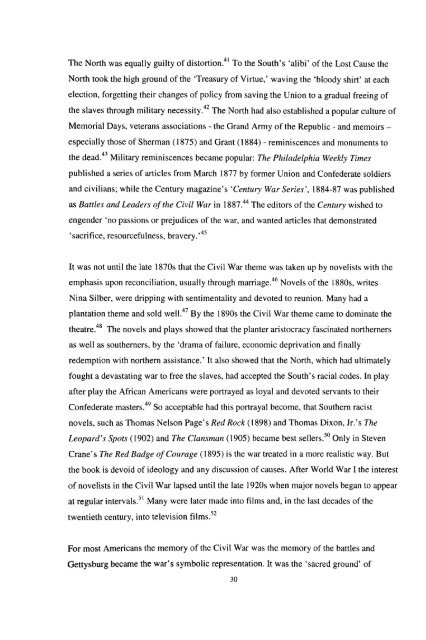Download (3483kB) - Greenwich Academic Literature Archive ...
Download (3483kB) - Greenwich Academic Literature Archive ...
Download (3483kB) - Greenwich Academic Literature Archive ...
- No tags were found...
You also want an ePaper? Increase the reach of your titles
YUMPU automatically turns print PDFs into web optimized ePapers that Google loves.
The North was equally guilty of distortion.41 To the South's 'alibi' of the Lost Cause theNorth took the high ground of the Treasury of Virtue,' waving the 'bloody shirt' at eachelection, forgetting their changes of policy from saving the Union to a gradual freeing ofthe slaves through military necessity. 42 The North had also established a popular culture ofMemorial Days, veterans associations - the Grand Army of the Republic - and memoirs -especially those of Sherman (1875) and Grant (1884) - reminiscences and monuments tothe dead.43 Military reminiscences became popular: The Philadelphia Weekly Timespublished a series of articles from March 1877 by former Union and Confederate soldiersand civilians; while the Century magazine's 'Century War Series', 1884-87 was publishedas Battles and Leaders of the Civil War in 1887.44 The editors of the Century wished toengender 'no passions or prejudices of the war, and wanted articles that demonstrated'sacrifice, resourcefulness, bravery.' 45It was not until the late 1870s that the Civil War theme was taken up by novelists with theemphasis upon reconciliation, usually through marriage.46 Novels of the 1880s, writesNina Silber, were dripping with sentimentality and devoted to reunion. Many had aplantation theme and sold well.47 By the 1890s the Civil War theme came to dominate thetheatre. 48 The novels and plays showed that the planter aristocracy fascinated northernersas well as southerners, by the 'drama of failure, economic deprivation and finallyredemption with northern assistance.' It also showed that the North, which had ultimatelyfought a devastating war to free the slaves, had accepted the South's racial codes. In playafter play the African Americans were portrayed as loyal and devoted servants to theirConfederate masters.49 So acceptable had this portrayal become, that Southern racistnovels, such as Thomas Nelson Page's Red Rock (1898) and Thomas Dixon, Jr.'s TheLeopard's Spots (1902) and The Clansman (1905) became best sellers.50 Only in StevenCrane's The Red Badge of Courage (1895) is the war treated in a more realistic way. Butthe book is devoid of ideology and any discussion of causes. After World War I the interestof novelists in the Civil War lapsed until the late 1920s when major novels began to appearat regular intervals. 51 Many were later made into films and, in the last decades of thetwentieth century, into television films.52For most Americans the memory of the Civil War was the memory of the battles andGettysburg became the war's symbolic representation. It was the 'sacred ground' of30
















